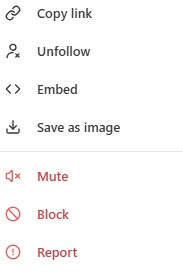Three Steps to Fix Your Social Media Algorithm
Substack, Facebook, Instagram, X…Well, Maybe Just Delete X
Not long ago, another writer on Substack and I spent some time direct messaging each other to lament Substack’s “Notes” feed. We felt it had, shall we say…(d)evolved. As they put it, “It has become a maelstrom of complaints, virtue signaling, and relentless self-promotion. If I see one more humble brag ending with, ‘it’s never too late to start’, I’m going to burst a blood vessel.”
Your algorithm is broken working as designed, and while the fix is simple to understand, it's difficult to practice consistently. It involves self-awareness, honesty, and intentionality.
Consider the following to be generally true:
Your social media algorithm, when it comes down to it, is a reflection of your online behavior, and thus, a reflection of you.
There are, obviously, caveats.
Not everything in your feed is your fault.
Curiosity does not equal endorsement.
People change.
That said, let’s discuss how you might take action to tweak your algorithm so it doesn’t leave you feeling such consternation.
Begin by taking a mental inventory of what you're seeing on your feed. This shouldn't take long. I spent about 5 minutes taking a bit of a algorithmic self-inventory and these are the things I found to be monopolizing my feed.
Topic One: Deconstructing or deconstructed evangelicals.
Why I’m Seeing It
I’ve written a lot of posts that show how I’ve diverged from the world of Evangelical Christianity. I completely understand a desire to distance oneself from theological leanings we once held true.
The Problem
I think I might have reached a saturation point. Where one thing dies, something else should grow, and cynicism is a toxic fertilizer. I mean really, if I see the word exvangelical one more time, I’m going to experience an aneurism of my own.
Topic Two: Divorced women writers who have found a way to thrive.
Why I’m Seeing It
Anyone who’s read my work in recent months knows that I’ve developed somewhat of a writing niche when it comes to marriage. One reader described my niche as, “Don’t be an asshole husband.” I didn’t know I had a niche, but it seems to fit this particular chapter of my writing life.
In learning how to speak to men who’d like to be better husbands, I’ve read a lot of work by divorced women. Most of the time their writing is not particularly appreciative of their ex-spouse, understandably so.
As a result of my reading research, the algorithm sends me more of the same– articles or notes by wives who are, one way or another, writing about their discontent in their marriage, how they found their way out, and how others might too.
The Problem
I have a bit more hope for husbands that the lived experience of the authors the algorithm has been feeding me, and I find myself getting defensive.
Topic Three: People writing about their fantastic sex life and how mine can be too.
I fit into a group of people who were raised in the purity culture of the evangelical church and have discovered, later in life, that sex is different than it was presented to us growing up. We’re shedding the shame about liking sex or watching others have sex. Shedding shame is a good thing.
But…Recently, the algorithm sent me an article about a woman whose favorite lover is a rock. I didn’t actually read it, but the image kind of screams ‘new age personal wellness tool.’ The kind of personal tool that might send the pearl clutchers straight to their fainting couches, back of their palm to their forehead.
I’m quite happy for her having a favorite lover, but I don’t want to read about it.
Why I’m Seeing It
Turns out, I’d subscribed to this author’s Substack.
The Problem
I just don’t want to read about it anymore. Not in my inbox or my media feed.
Topic Four: Anything relating to the poster’s subscriber counts.
The passive-aggressive but nice people who are posting notes that should be coffee-break conversations with others. You know, face to face. “I started my Substack two weeks ago…I’m up to 5 subscribers which isn’t much but I’m proud of the effort!”
Why I’m Seeing It
I’m a writer like these people, with an ego just like them. I’ve lingered on these notes and liked no small number of them. I’ve even posted a note or two like these myself.
The Problem
Part of me relates to these posts because I am a writer. I do want connection and affirmation. But another part of me resents how performative or self-congratulatory they feel and I don’t want to play that game.
Topic Five: Writing about how to be successful on Substack
If you are here to coddle the algorithm…there are about 15 gazillion writers on Substack who want to tell you how to do it.
Pardon the unsolicited rant, but I can’t help myself.
These are the people writing about writing, and they drive me nuts. The thing is, they are similar to actual nuts, which I don’t really have much of an appetite for, ever, yet I can’t stop eating once I’ve munched on the first shelled walnut.
I think 90% of these people are drinking their own snake oil. I’ve looked kind of deep into some of them. I’ve Googled their names and looked for them on youtube, Medium and various other places on the internet. The ONLY thing I can ever see that they’ve ever done is write about writing online and telling other people how to do it. “I started my writing business 2 years ago and here’s how you can too...”
Your writing business? What have you written about besides writing?
They don’t even try to hide it. A Substack “coach” recently explained that their first newsletter niche tanked, so they abandoned it. Their next project? A Substack on how to be successful on Substack. Naturally, that one exploded in popularity.
It’s somewhat infuriating1.
Why I’m Seeing It
Because with a desire to grow my Substack, I’ve fallen for the click-bait articles. I’ve lingered on them, read them, and even commented on some.
The Problem
I’m feeding a system I’d rather see die, and then eating its leftovers.
Steps to Personally Curating Your Feed
Once you’ve taken inventory of your feed, be intentional about how you interact with it moving forward. Remember: algorithms operate with one thing in mind: to make you react. If something keeps appearing in your feed, it's because you've somehow signaled engagement. Here’s what engagement looks like to the algorithm:
Clicking the Heart or “liking” a post - Even a quick, thoughtless tap registers as positive feedback.
Commenting - Any response, positive or negative, signals high interest.
Sharing or reposting - Shows the algorithm you want others to see this content.
Clicking through to read - Time spent on a post matters more than you think, even if you don’t like, comment, or share it with others.
Following links - Clicking external links signals engagement.
Lingering on posts - Believe it or not, simply pausing to read tells the algorithm you're interested.
Fortunately, if you keep these things in mind, curating a social media feed that is pleasing to you isn’t much more difficult than it was to curate the one that isn’t.
Step 1: Unsubscribe from Substack accounts you no longer have interest in.
People–including you–change. It’s completely normal, and it’s ok to leave past interests in the past. This is happening to me as a writer, which is even a bit more difficult to navigate. But I’m finding as I re-curate my inbox, I’m also freeing up creative space in this brain of mine.
Look at the inventory you took of your feed. It’ll help you understand who you are, at least in your online world. Take note and adjust your interactions accordingly.
Step 2: Limit your engagement with notes and posts.
The less you engage with a particular topic–be it a note or post–the less likely the algorithm is to send it to your feed. “Like” things you actually like, the things that you’ve taken a bit of time to think about. Don’t click the Like button in a thoughtless manner. At least think about it as much as the algorithm is noticing your behavior.
Step 3: Talk to the algorithm.
This one takes a bit more work, but we’re talking mere seconds. If you click the three dots next to a post on your feed (I’ve put a red box around them in the image below) you will be offered several ways to tell the algorithm you’re not interested in what you’re seeing.

After clicking those three little dots, you’ll see the following drop-down menu. Consider it an algorithm communications toolbox!
Unfollow: This option allows you to unfollow somebody you’ve previously followed. You’ll stop seeing their Notes or posts in your feed, but they won’t be notified.
Mute: Mute hides a person’s Notes from your feed without unfollowing them. It’s a quiet way to take a break from their content without severing the connection.
Block: Blocking removes someone’s ability to follow you, comment on your Notes or posts, or interact with you on Substack. Their content will also be hidden from your feed.
Report: This option flags a user or specific content for review by Substack’s moderation team—typically for spam, harassment, or violating platform guidelines.
Remember, the algorithm curates what you see automatically based on activity it’s seen from you in the past. Any time I engage with a post or note, the algorithm takes it as a sign I might like to see more from that person, even though I haven’t followed or subscribed to them. This might be one answer to Pamela’s question (in the picture above).
If the algorithm will always be a reflection of your online behavior, then the question is whether you want that reflection to be intentional or accidental. The inventory you took reveals where you've been letting the algorithm steer you instead of steering it.
Taking control requires the same three elements I mentioned at the start: self-awareness to recognize what you're actually seeing, honesty about how you got there, and intentionality in every interaction moving forward.
The change happens faster than you'd expect. Within days, your feed will start reflecting your actual interests rather than your reactive patterns. Your algorithm will work as you design it to work.
Make it work for you.
If you are looking for help with Substack, look for someone who’s spent some time doing writing work and knows a bit about the craft. I recommend the community of writers over at Substack Writers at Work with Sarah Fay. Sarah has the educational and professional experience to know what she’s talking about when it comes to writing. Her book, Pathological: The True Story of Six Misdiagnoses, just made the USA Today’s best seller list.
Sarah was helpful for me. When I followed her advice, I experienced growth. When I didn’t, things slowed.
If you’re looking for help with the artistic side of your Substack, reach out to Nan Tepper at Style Your Stack. Not only is Nan a tremendous artistic talent (who is currently working on stylin’ my ‘stack…stay tuned…) but she’s a talented writer whose weekly articles teach me how to be a better person.
Then again, if you’re willing to sacrifice your integrity at the altar of contrived Substack growth, then double-down on your Circular Reasoning fallacy and start your own Newsletter about how to have a successful newsletter even though you’ve never had a successful newsletter.
You’ll grow in spades!




